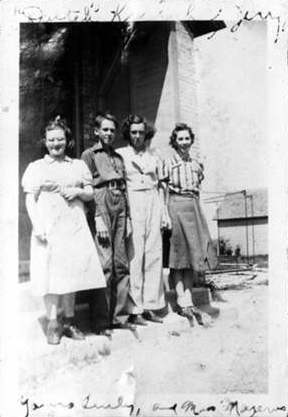
|
|

|
|
After Kohlsville we started a two-day journey farther afield. We learned from Jerry Apps' book, "One-Room Country Schools", that the Galloway House and Village complex contains Willow Lawn School which was purchased by the Fond du Lac County Historical Society in 1963 and moved to the present site after it had spent over a century of remodeling and add-ons. It is one of the earliest one-room schools in the country.
Galloway House and Village is an on-going project of the Historical Society and contains besides the school building, an elaborately furnished thirty-room Victorian mansion, train depot, log cabin, a general store, many shops typical of the earlier part of the century and other collections and museums. The Village charges an entry fee. After a soup and salad lunch, we headed out of Fond du Lac to New London where we arrived at a pleasant little park, the New London Heritage Historical Village, just before closing time. There are five buildings which have been moved to the site and have been restored. One of the buildings is a Chicago and Northwestern Train Depot from 1923. Behind the depot is a Soo Line Caboose, our first inside look at a train caboose which, it seems to me, could serve as a compact little summer cabin.
The school, formerly called Elms School and now Triangle School, is a good example of a rural school. It was built in 1847 and remained in use until 1948. Originally built of brick, it was later sided with wood. Upon comparing an old black and white photo with a new, color shot, it would appear that more than siding was changed. The roof line is different and some windows were covered and smaller ones added to the front of the school.
Nineteen desks, a pot-bellied stove, teacher,s desk, kerosene lamps, an old world globe, and a pendulum clock (still known as school clock) fill the room. At the back of the room is a water crock and a row of lunch buckets, some old syrup pails which were commonly used by the pupils to carry their lunch to school. The water crocks were an important feature of the up-to-date rural school. Before the crocks came on the scene, an open bucket and dipper were used for drinking water. Apparently, nobody worried about contagious diseases back in those days.
By the time we drove the next distance to Shawano, to see the one-room school on the Wolf River Pond, it was closed. Located in Heritage Park at North Franklin Street overlooking the pond, it was a pretty little site for a school. The old iron pump remains in place outside the school building; it was made by the Trahern Pump Co., of Rockford, Illinois.
Since the day had come to an end and we were still far from the next school on our list, we headed for Eagle River to bed down for the night in a plain and pleasant motel room.
Early in the morning, after a continental breakfast of soggy donuts, ordinary orange juice and a couple excellent cups of coffee, we took a nostalgic side trip to our family cottage where my husband and a passel of our ten kids in tow, had spent some happy, some bittersweet hours a long time ago. It was an overcast morning and very cool for July, so cool we changed from shorts to slacks and warm socks inside our sandals. Except for forest sounds and the rush of water over the dam, there was no sound, no human sound.There on the bank of the flowage, where my parents spent so much time in their older years, I felt strongly their presence. I wished later we had stayed longer. Dad loved to fish and went out on the lake every day and would ask Mom to go along but she always refused, probably because she was afraid of the water. One day he said to her, "Kid (their private name for each other even until he died in his late seventies), I will ask you one more time to go fishing with me and I will never ask you again." She went, and from then on, went with him almost every time he went out in the boat.
 Comments?
lou@designcoalition.org
Comments?
lou@designcoalition.org